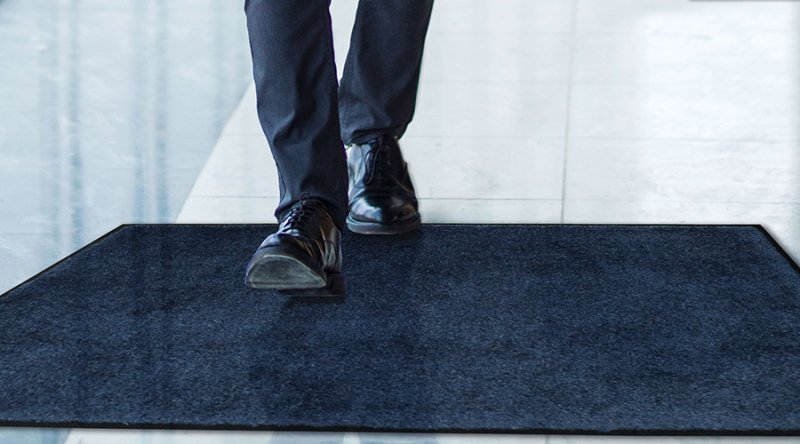When it comes to floor mats, they should have a slip-resistant rubber backing to keep them from sliding around on the floor. Look for a label from the National Floor Safety Institute (NFSI) on the back of the mat that certifies that the mat has been tested by the NFSI to ensure a high level of slip resistance. The edges of floor mats with a thickness greater than 14 inches should be beveled to prevent potential tripping hazards. To ensure easy visibility, the slope of the bevel should not be greater than 1:2 and the color of the bevel should contrast with the color of the floor.
What is the best location for floor mats? The most obvious location for a floor mat is near the entrances and exits of your building, as these are the areas that receive the most foot traffic. Mats are also required in areas where the floors are susceptible to becoming wet, such as drink dispensers, ice machines, sinks, and dishwashing stations.
Logo mats are a viable option for reducing the risk of slip and fall exposures, but proper maintenance is required. Floor mats must be cleaned regularly to ensure that dirt and moisture are removed from the mats and that the mats continue to function properly. Mats that are worn, damaged, or have curling edges increase the likelihood of tripping and should be replaced as soon as possible.
It makes no difference whether you own the floor mats or if you rent them from service. Slip and fall exposures at your facility can be reduced by using the proper type of floor mats, keeping them in good condition, and keeping them properly maintained. Keep in mind that being inexpensive does not always equate to being effective. For more information on the size and number of mats, you will require to protect your employees and customers, contact your local floor mat company. Then determine whether it is more cost-effective to own or rent the rugs.
Don’t miss our video training session, “Slips, Trips, and Falls Risk Management: Floor Mats,” for more information on the importance of floor mats in preventing workplace slips, trips, and falls.
What steps can managers take to ensure that mats do not become a trip hazard?
This is an extremely serious issue. While most standard rubber-backed carpeted floor mats do a reasonable job of reducing slips and falls, they frequently increase the risk of trips and falls as well. This is because they ripple and bunch up after use, as a result of the fatigue of laundering, and as they grow older.
The purchase of the appropriate product and the appropriate amount of matting for the job can help managers avoid mats becoming a trip hazard. Managers will see a quicker return on investment if they invest in the correct mat up front, as a higher quality product saves money in the long run. Edging is also an important component of matting because it helps to ensure a smooth transition from the floor to the mat. Simply lying on the floor, thicker mats without proper edging can cause a trip and fall accident.
The weight of the mat, as well as its crush resistance and absorption, should be considered when selecting one. Furthermore, they must be on the lookout for curled edges and buckles. If this occurs, the machine must be taken out of service and replaced with another one. At all times, the mat should be completely flat on the floor. It is recommended that you clean and vacuum your mat regularly to get the most out of it. The proper storage of your mat will also help to extend the life of the mat. Never store a mat in an upright position. Curling or deformation of the edges will result as a result of this.
Maintain the matting to ensure that it is clean and dry enough to perform its function properly. Make certain that mats are laid out flat, with no wrinkles or curled edges, and that they are securely fastened in place. Transitions from one type of flooring or matting to another should be level or within the ADA compliance guidelines.
The most important thing is to manage the mats effectively. Maintaining and monitoring mats while paying close attention to mat movement issues, saturated wet mats, soiled mats, edges that are torn or curled, and other potential trip or slip hazards can help prevent trip and slip accidents. It is critical to act quickly and replace any mats that are showing signs of wear.
Check Out Our Blog: How To Know The Quality Of A Knife?

